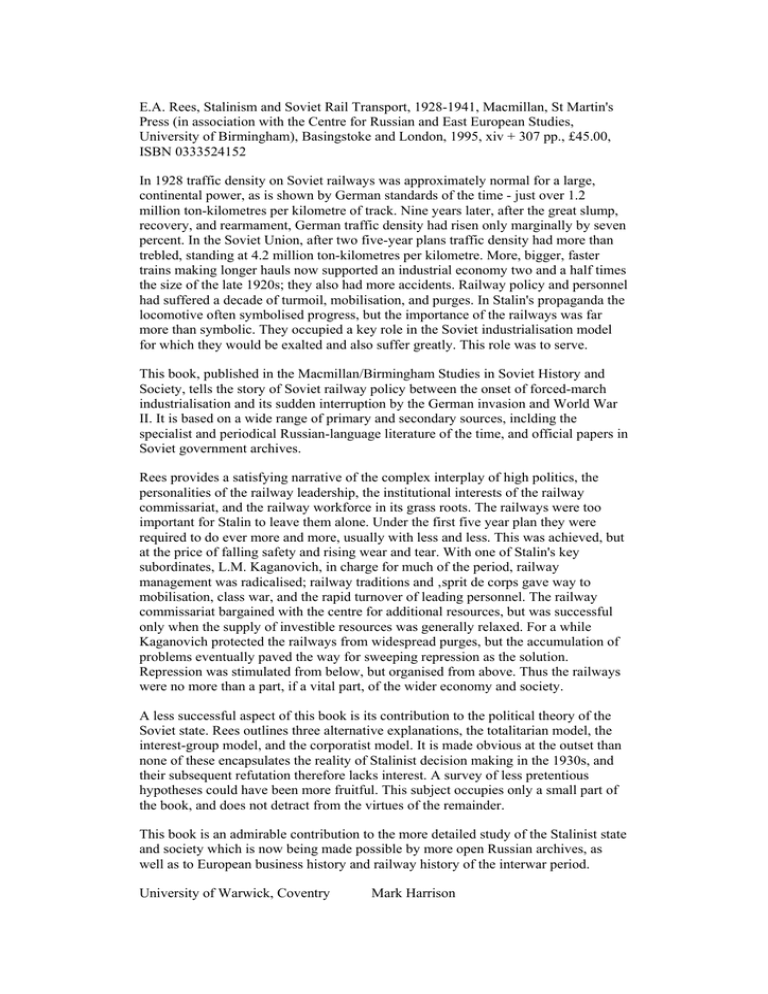E.A. Rees, Stalinism and Soviet Rail Transport, 1928-1941, Macmillan, St... Press (in association with the Centre for Russian and East...
advertisement

E.A. Rees, Stalinism and Soviet Rail Transport, 1928-1941, Macmillan, St Martin's Press (in association with the Centre for Russian and East European Studies, University of Birmingham), Basingstoke and London, 1995, xiv + 307 pp., £45.00, ISBN 0333524152 In 1928 traffic density on Soviet railways was approximately normal for a large, continental power, as is shown by German standards of the time - just over 1.2 million ton-kilometres per kilometre of track. Nine years later, after the great slump, recovery, and rearmament, German traffic density had risen only marginally by seven percent. In the Soviet Union, after two five-year plans traffic density had more than trebled, standing at 4.2 million ton-kilometres per kilometre. More, bigger, faster trains making longer hauls now supported an industrial economy two and a half times the size of the late 1920s; they also had more accidents. Railway policy and personnel had suffered a decade of turmoil, mobilisation, and purges. In Stalin's propaganda the locomotive often symbolised progress, but the importance of the railways was far more than symbolic. They occupied a key role in the Soviet industrialisation model for which they would be exalted and also suffer greatly. This role was to serve. This book, published in the Macmillan/Birmingham Studies in Soviet History and Society, tells the story of Soviet railway policy between the onset of forced-march industrialisation and its sudden interruption by the German invasion and World War II. It is based on a wide range of primary and secondary sources, inclding the specialist and periodical Russian-language literature of the time, and official papers in Soviet government archives. Rees provides a satisfying narrative of the complex interplay of high politics, the personalities of the railway leadership, the institutional interests of the railway commissariat, and the railway workforce in its grass roots. The railways were too important for Stalin to leave them alone. Under the first five year plan they were required to do ever more and more, usually with less and less. This was achieved, but at the price of falling safety and rising wear and tear. With one of Stalin's key subordinates, L.M. Kaganovich, in charge for much of the period, railway management was radicalised; railway traditions and ‚sprit de corps gave way to mobilisation, class war, and the rapid turnover of leading personnel. The railway commissariat bargained with the centre for additional resources, but was successful only when the supply of investible resources was generally relaxed. For a while Kaganovich protected the railways from widespread purges, but the accumulation of problems eventually paved the way for sweeping repression as the solution. Repression was stimulated from below, but organised from above. Thus the railways were no more than a part, if a vital part, of the wider economy and society. A less successful aspect of this book is its contribution to the political theory of the Soviet state. Rees outlines three alternative explanations, the totalitarian model, the interest-group model, and the corporatist model. It is made obvious at the outset than none of these encapsulates the reality of Stalinist decision making in the 1930s, and their subsequent refutation therefore lacks interest. A survey of less pretentious hypotheses could have been more fruitful. This subject occupies only a small part of the book, and does not detract from the virtues of the remainder. This book is an admirable contribution to the more detailed study of the Stalinist state and society which is now being made possible by more open Russian archives, as well as to European business history and railway history of the interwar period. University of Warwick, Coventry Mark Harrison







